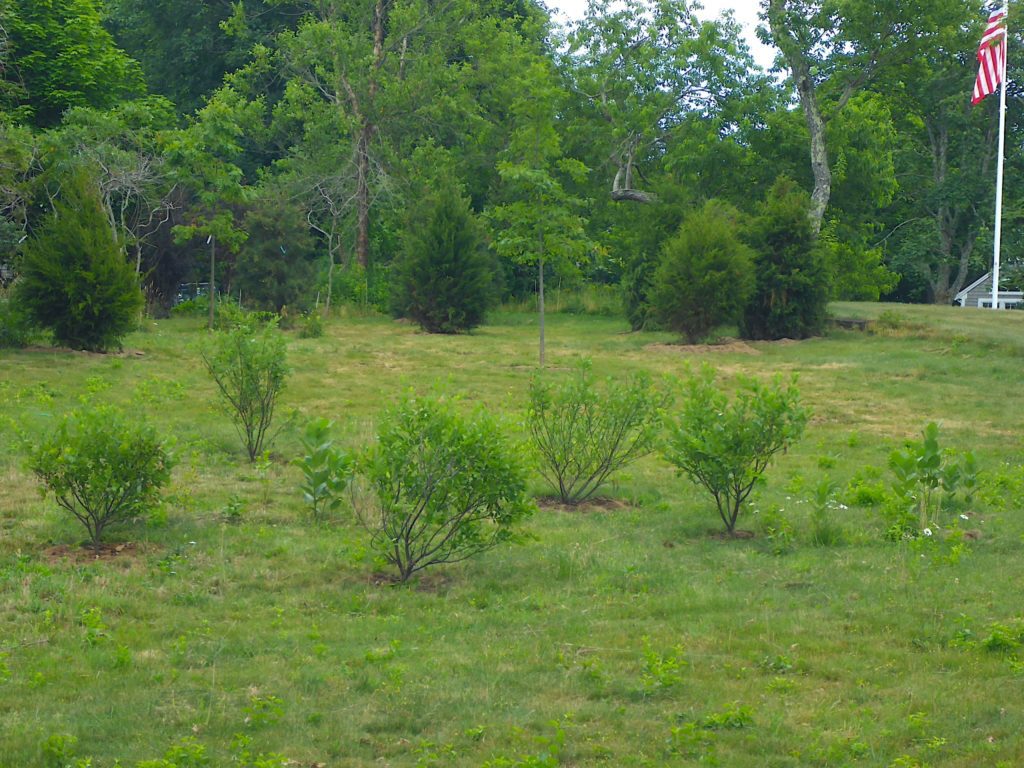By Cathy Weston
This article originally appeared in the Goldenrod Garden and is reprinted with the permission of the author.
Usually, it happens when I am weeding – I have spent a solid hour weeding that long border or removing invasives and garden thugs, and I get to the end, stand up to stretch my back, and without even looking hard I see some I missed. No matter how thorough the weeding job, there are always more — weeds, or invasives, or garden thugs. Sometimes it seems like the work is never-ending. “There is always more” could be the sub-title of this gardener’s life, and the life of every gardener I know.

Weed piles after removing the ground ivy from the Glory Garden daylilies – they looked a lot bigger in person!
When I get discouraged, I try to remember that there is always more joy to gardening, too. More plants to try, more tweaks to make designs more effective, more butterflies to identify, more quiet afternoons just enjoying the garden, more gardening friends to meet, and always more to learn.
These late fall days I’m compiling my “more” lists to think about over the winter. Here’s a sampling:
More Design Tweaks
Fill in that hole in the pollinator border with a tall plant like the rattlesnake master I saw in a friend’s garden. Thin out the sundrops in the Glory Garden and interplant with something that blooms in mid-summer, when the sundrops have finished. Replace that volunteer spirea shrub with another big patch of anise hyssop. Add a few more ferns to the shady corner garden.

See those lady ferns on the left? Need more clumps of ferns in the center and on the right.
More New Planting Beds
I’d love to double the size of the pollinator border, maybe expanding it in a curving pattern to include the Kousa dogwood in one corner. I might also tackle the wide-open upper field, with the opportunity for plants that need a lot of space – I’m thinking Virginia rose, hay-scented fern, and milkweed. This means I get more practice in planting design, too.

Look at all that empty space around the newly-planted beach plums!
More Ecological Practices Incorporated Into Gardening Routines
I’ve been scaling back the supplemental water in my established native plant beds, such as the woodland. Next year I will let them rely on rainfall (while reserving the right to water in a severe drought). Watering will focus just on the newly-planted areas and a few thirsty non-natives.
More New Plants to Try
I mentioned the rattlesnake master already, it seems like a very cool plant. I have my eye on some new shrubs – elderberry, maple-leaf viburnum and spicebush – and I think I have a good sunny dry spot for bearberry.

Bearberry on a dry slope on the Chatham spur of the Cape Cod Rail Trail, with white oak seedlings. There are several dry slope areas in the upper field that would work for this ground cover.
More Sharing of Native Plant Information and Inspiration
It’s been gratifying to talk with so many people this summer who are interested in using native plants. It seems they don’t really know how to incorporate them into their beds – there must be something I can do to help, maybe some more teaching or a webinar.
More Learning – Always
Every fall/winter there is a wealth of learning opportunities, both online and in-person. Whether it’s a design-oriented garden tour, a specific horticultural subject, or a review of a certain category of plants, I come away with ideas and inspirations. Right now I’m thinking about courses to deepen my understanding of the science of ecology, plant communities, and woodland restorations, as well as more design courses; the ELA (Ecological Landscaping Association) and the Native Plant Trust will be my starting points.
What’s on your “There is always more” list?
About the Author
After a business career and a lifetime of traditional gardening, Cathy Weston embarked on a journey to become a garden ecologist and native-plant landscape designer. She completed a Certificate in Native Plant Horticulture and Design from the New England Wild Flower Society. She writes a blog www.goldenrodgarden.com about using native plants in her Cape Cod garden.
Besides her own gardening, she volunteers with the horticulture staff at the Rose Kennedy Greenway Conservancy in Boston as a regular zone gardener and as a horticultural writer. She is a Trustee at the Chatham Conservation Foundation, the land trust serving Chatham MA, and serves on the Board of the Friends of Sylvan Gardens, a conservation area in Chatham, MA.
***
Each author appearing herein retains original copyright. Right to reproduce or disseminate all material herein, including to Columbia University Library’s CAUSEWAY Project, is otherwise reserved by ELA. Please contact ELA for permission to reprint.
Mention of products is not intended to constitute endorsement. Opinions expressed in this newsletter article do not necessarily represent those of ELA’s directors, staff, or members.

